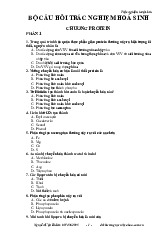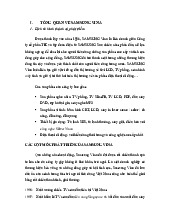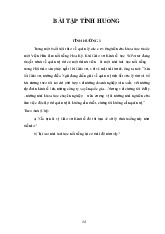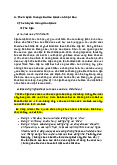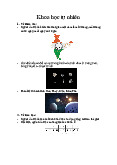

Preview text:
Cà Mau là tỉnh cực nam của Tổ quốc, nằm trong khu vực đồng bằng sông Cửu Long. Cà Mau có ba
mặt giáp biển, là nơi giao thoa giữa văn hóa Việt, Khmer. Cà Mau còn được biết đến với tên gọi
khác là Tưk Kha-mau, có nghĩa là nước đen, do màu nước đặc trưng của rừng tràm U Minh. Cà
Mau là vùng đất mới được khai phá khoảng trên 300 năm, là điểm dừng chân cuối cùng của người
Việt trên bước đường Nam tiến.
Người dân Cà Mau có nhiều đặc điểm riêng biệt, phản ánh bản sắc văn hóa đa dạng và phong phú
của vùng đất này. Họ là những người hiếu khách, thân thiện, chân chất và chịu khó. Họ sống chủ
yếu bằng nghề nông, lâm, ngư nghiệp, thích nghi với điều kiện tự nhiên khắc nghiệt của đầm lầy,
biển đảo. Họ cũng có nhiều tài năng trong nghệ thuật, thể hiện qua các hình thức văn hóa dân gian
như ca dao, tục ngữ, dân ca, hát Quảng, múa Lân, …
Thời tiết: Cà Mau có khí hậu nhiệt đới gió mùa, nóng ẩm quanh năm.
Mùa mưa từ tháng 5 đến tháng 11, thường có mưa to, giông lốc.
Mùa khô từ tháng 12 đến tháng 4, ít mưa, nắng nhiều.
Phong tục truyền thống của người dân Cà Mau cũng rất độc đáo và đậm đà bản sắc. Họ có nhiều lễ
hội đặc sắc, như lễ hội Đất Mũi, lễ hội Nghinh Ông, lễ hội Tết Nguyên đán... Trong các dịp lễ tết, họ
thường trang trí nhà cửa, chùa chiền bằng đèn kết hoa, dán các mảnh giấy màu đỏ với dòng chữ
chúc mừng. Họ cũng có nhiều món ăn truyền thống, như bánh tét, bánh xèo, bánh căn, bánh pía,
bánh tẻ... Họ cũng có nhiều món ăn đặc sản, như tôm, cua, ba khía, ốc len, cá bống, cá thát lát,…
Cà Mau là một vùng đất đẹp, giàu tiềm năng và có nhiều nét văn hóa độc đáo. Người dân Cà Mau
luôn tự hào về quê hương mình, luôn gìn giữ và phát huy những giá trị truyền thống của tổ tiên. Họ
cũng luôn có tinh thần yêu nước, bất khuất chống giặc ngoại xâm, đoàn kết, tương thân tương ái, lá
lành đùm lá rách. Họ cũng luôn hướng về phía trước, phấn đấu xây dựng quê hương ngày càng phát
triển, hòa nhập với cả nước và thế giới.
My full name is Lại Đan Trường. Please call me Trường
Educational background: I studied at VH university 4 year. My major subject is entrepreneurship{oh
trơ ri ner ship}. I learned the necessary{len nờ đờ nét cơ ray} things when starting a business. The
main things I gained from my education are skill, knowlage, language, behavior.
Job history: I worked as customer
{ cớn tơ mờ} care staff at Novaland company for 1 year. I solve problems
{ sô ró lèn} and answer customer question In addition, I also meet customer to introduce new
products. My job involves connerding customer with business, promoting. Sen timent with the brand community
Cà Mau is the southernmost province of V {p ró mền}
ietnam, located{ló cà đền} in the Mekong Delta
region{rí trèn}. Bordered{bó đền}by the sea on three sides, Cà Mau is a cultural melting{ cau trô meo
ting} pot of Vietnamese and Khmer influences{in plu sen}. It is also known by its alternative {ó chén
nơ tẹp} name, "Tưk Kha-mau," which means{min} "black water," referring{rì pớn ning} the
characteristic{kén ra rịc tịch} color of the U Minh mangrove forest. Cà Mau is a characteristic{kén ra
rịc tịch} new land, only being developed{đì vé lọt} for about 300{truy hớn đơ} years, and it marks the
final destination{đát ti náy sền} of the Vietnamese people on their southward journey{sou quơ tró nì}.
The people of Cà Mau possess{pò sen} many unique characteristics{kén ra rịc tịch} that reflect the
rich and diverse cultural identity{cou tro ài đén ti y} of this land. They are known for their
hospitality{hóp pi ta ly đi}, warmth, sincerity, and hard work. They primarily{pai mé ra ly} make a
living from agriculture{á ri cou trờ}, forestry, and fishing, adapting to the harsh natural conditions
of the swamps and islands. They are also talented{tá lần teo} in the arts, as expressed through
various forms of folk culture such as proverbs, folk songs, singing, Lion dance , and more.
The traditional customs of Cà Mau's people are also unique and deeply rooted in their cultural
identity{cớt tu ra ìn đến ty ni}. They celebrate{séo bơ ray} many distinctive festivals{ dít sín tơ pén
sơ bồ}, such as the Dat Mui Festival, the Nghinh Ong Festival, and the Tet Nguyen Dan
Festival{pén sơ pồ}. During these festivals, they decorate their houses and temples with colorful
lanterns and flowers{lén tèn and lau ờ}, and paste red paper with auspicious messages. They also have a variety of traditional
dishes, such as banh tet (glutinous rice cake), banh xeo {tra đít sền nồ}
(crispy pancake), banh can (mini pancake), banh pia (mung bean cake), and banh tet (steamed rice
cake). Cà Mau is also famous for its specialities{sép si à li ty} such as shrimp{sem}, crab, apple
snail, mudskipper{mớt kẹp pờ}, and catfish.
Cà Mau is a beautiful land, rich in potential and possessing {pờ tén tin and pó si sing} many unique
cultural features. The people of Cà Mau are always proud of their homeland, constantly preserving
{ cón tá ly rì sớ ving} and promoting the traditional values{tra đít ti sền vá lền} of their
ancestors. They also possess a strong spirit of patriotism{pít rì tó sèn}, fearlessly fighting against
foreign invaders, and are united in mutual love and support, always helping those in need. They are
always looking towards the future, striving to develop their homeland day by day, integrating{ín tơ
ráy đing} with the rest of the country and the world.
